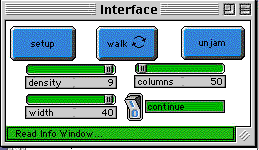
First Step: ----------- The model is designed to run in 2 by 2 patch size with SCREEN-EDGE-X Size: 135 and SCREEN-EDGE-Y Size: 149. Due to complications in the program, it is not currently saving in this mode. Please set the program to these settings before using. What is it? ----------- This is a model of pedestrian crosswalk traffic. Each red turtle represents a pedestrian moving from the right to the left, each white moving left to right. Social scientists have observed that human banding is commonly displayed in high density crosswalks. In place of random movements, people move in coordination with others traveling in the same direction in order to avoid oncoming pedestrian traffic. In order to demonstrate such a phenomenon, this model assumes two general laws of travel followed by humans within the crosswalk. 1) When confronted head-on by a human moving in the opposite direction, each human will step either to the right or left. 2) In order to maximize efficiency, each human will follow the travel of an individual in front of them, whether he/she is directly or diagonally ahead of them. How to use it? -------------- This model is meant to model the emergent properties witnessed in a social phenomenon. More specifically, it attempts to re-create, through simple rules, what researchers have only been able to observe in real life. It is also meant to be a measure of the different effects of such factors as "density" "width" and "columns". The DENSITY slider affects the proportion of patches that initially sprout a turtle at both screen edges. The higher the density, the more patches sprout humans. The COLUMNS slider defines how many waves of people enter the crosswalk. In other words, the slider determines how many columns of turtles approach the road from each direction. The WIDTH slider determines the total area of the crosswalk. The white lines illustrate the current width and the borders for where turtles are allowed to travel. If a turtle travels outside the crosswalk, it dies. The CONTINUE switch allows the user to choose the turtle's activities once it reaches its destination. Once the turtle makes it across the road, it can either stop at the edge of the screen, therefore causing backup across the screen, or can continue to the other side of the screen along its current pattern. When the continue switch is set to 0, the turtles move along in a normal manner. When it is set to 1, the turtles stack up at the edge of the screen so as to display the banding lines which they formed within the model. The UNJAM button redirects every turtle momentarily in order to free up "traffic jams" within the model. Extending the model. -------------------- The model could be extended in several ways. As it is, the model is subject to frequent backups or "jams", which require the Unjam button to clear up. While the intent of this is to show the natural patterns of backups, it could also be an area for expansion. How could one program each turtle to get itself out of a "jam"? What is the most efficient way to unclog backup? The model currently assumes that people only wish to move left and right within the crosswalk. What would happen if turtles were also programmed with the intention of travelling diagonally? Additionally, we can ask questions about other variables: What happens if we remove the assumption that each turtle moves at the same speed? Can we add a traffic signal? What if some turtles attempt to break out of the bands and form their own paths? Can you alter the program so that thicker bands form? STARLOGOT FEATURES ------------------- This model highlights the use of the SPROUT function in StarLogoT. In order to assign only one turtle to a patch at SETUP, the model uses SPROUT instead of CREATE-TURTLES. By doing so, each patch at SCREEN-EDGE-X and SCREEN-EDGE-X determine whether or not to create a turtle based upon the user's input through the density slider. Like the model FOLLOWER, this model uses the variable "follow" to latch onto another turtle. This variable is set to the other turtle's ID in the SEARCH function. REFERENCES and CREDITS ---------------------- This model derives from a study by Katsuya Yamori at Nara University entitled "Going With the Flow: Micro - Macro Dynamics in the Macrobehavioral Patterns of Pedestrian Crowds. The article can be found in: Psychological Review. 1998. Vol. 105, No. 3, 530-557 Copyright 1998 by the American Psychological Association, INC.